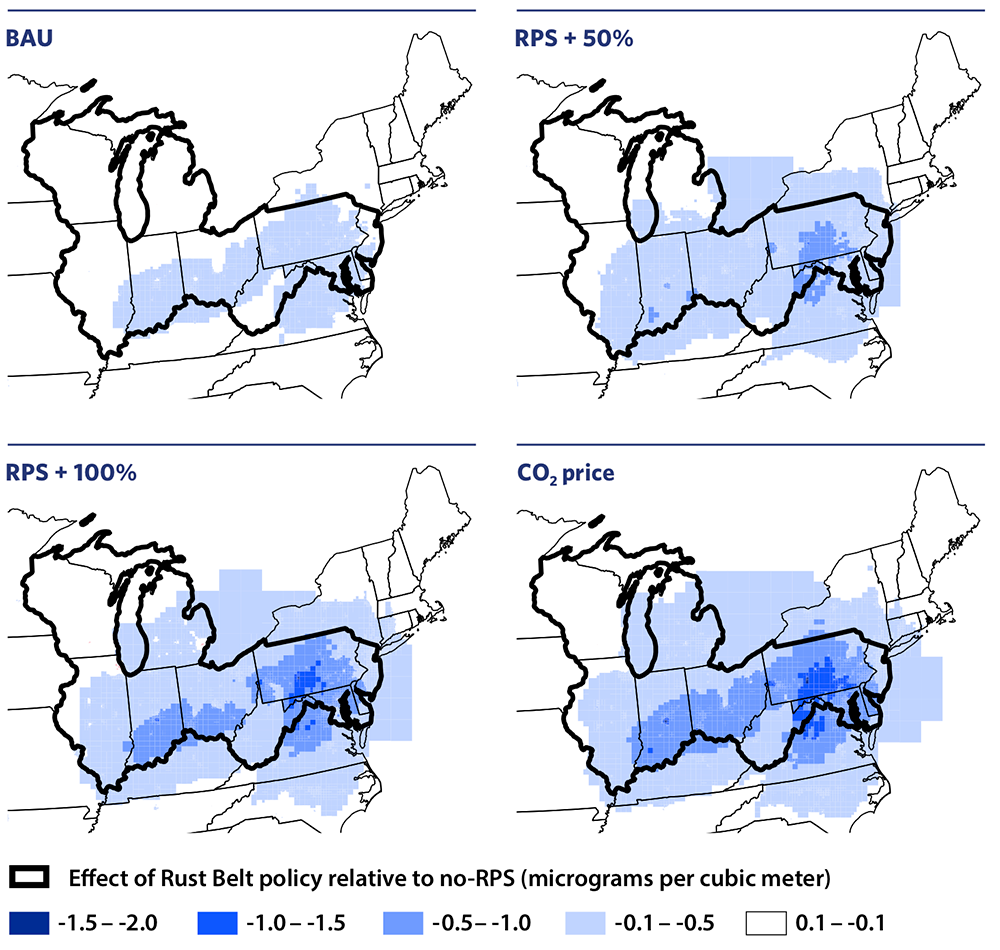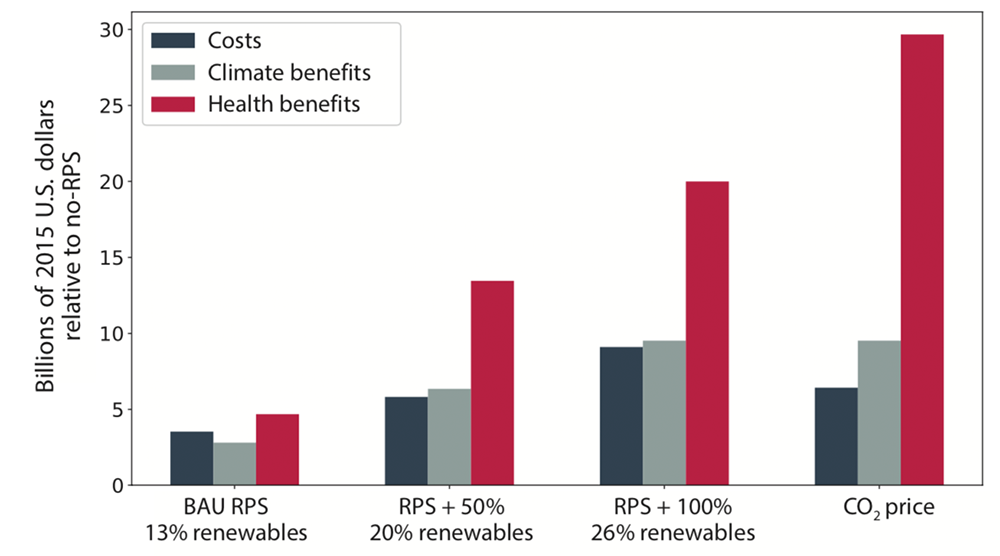
In brief
U.S. legislators in a number of states are now evaluating the costs and benefits of policies that require adoption of renewable energy. But they don’t generally consider the significant impacts of those policies on air pollution. Using linked economic and air pollution models, MIT researchers have found that renewable energy policies in the Rust Belt region could reduce air pollution so much that the savings from improved human health would exceed the costs of the policies by 2030. Moreover, making the policies more stringent would increase the health-related savings more rapidly than it would drive up the policy costs. The study also shows that imposing a price on carbon emissions would bring even greater health benefits at lower cost, but enacting such policies has proved politically challenging.
In the absence of federal adoption of climate change policy, states and municipalities in the United States have been taking action on their own. In particular, 29 states and the District of Columbia have enacted Renewable Portfolio Standards (RPSs) requiring that a certain fraction of their electricity mix come from renewable power technologies such as wind or solar. But now some states are rethinking their RPSs. A few are making them more stringent, but many more are relaxing or even repealing them.
To Noelle Eckley Selin, an associate professor in the Institute for Data, Systems, and Society and the Department of Earth, Atmospheric and Planetary Sciences, and Emil Dimanchev SM ’18, a senior research associate at the MIT Center for Energy and Environmental Policy Research, that’s a double concern: The RPSs help protect not only the global climate but also human health.
Past studies by Selin and others have shown that national-level climate policies designed to reduce carbon dioxide (CO2) emissions also significantly improve air quality, largely by reducing coal burning and related emissions, especially those that contribute to the formation of fine particulate matter, or PM2.5. While air quality in the United States has improved in recent decades, PM2.5 is still a threat. In 2016, some 93,000 premature deaths were attributed to exposure to PM2.5, according to the Institute of Health Metrics and Evaluation. Any measure that reduces those exposures saves lives and delivers health-related benefits, such as savings on medical bills, lost wages, and reduced productivity.
If individual states take steps to reduce or repeal their RPSs, what will be the impacts on air quality and human health in state and local communities? “We didn’t really know the answer to that question, and finding out could inform policy debates in individual states,” says Selin. “Obviously, states want to solve the climate problem. But if there are benefits for air quality and human health within the state, that could really motivate policy development.”
Selin, Dimanchev, and their collaborators set out to define those benefits. Most studies of policies that change electricity prices focus on the electricity sector and on the costs and climate benefits that would result nationwide. The MIT team instead wanted to examine electricity-consuming activities in all sectors and track changes in emissions, air pollution, human health exposures, and more. And to be useful for state or regional decision making, they needed to generate estimates of costs and benefits for the specific region that would be affected by the policy in question.
A novel modeling framework
To begin, the researchers developed the following framework for analyzing the costs and benefits of renewable energy and other “sub-national” climate policies.
- They start with an economywide model that simulates flows of goods and services and money throughout the economy, from sector to sector and region to region. For a given energy policy, the model calculates how the resulting change in electricity price affects human activity throughout the economy and generates a total cost, quantified as the change in consumption: How much better or worse off are consumers? The model also tracks CO2 emissions and how they’re affected by changes in economic activity.
- Next they use a historical emissions data set published by the U.S. Environmental Protection Agency that maps sources of air pollutants nationwide. Linking outputs of the economic model to that emissions data set generates estimates of future emissions from all sources across the United States resulting from a given policy.
- The emissions results go into an air pollution model that tracks how emitted chemicals become air pollution. For a given location, the model calculates resulting pollutant concentrations based on information about the height of the smoke stacks, the prevailing weather circulation patterns, and the chemical composition of the atmosphere.
- The air pollution model also contains population data from the U.S. census for all of the United States. Overlaying the population data onto the air pollution results generates human exposures at a resolution as fine as 1 square kilometer.
- Epidemiologists have developed coefficients that translate air pollution exposure to a risk of premature mortality. Using those coefficients and their outputs on human exposures, the researchers estimate the number of premature deaths in a geographical area that will result from the energy policy being analyzed.
- Finally, based on values used by government agencies in evaluating policies, they assign monetary values to their calculated impacts of the policy on CO2 emissions and human mortality. For the former, they use the “social cost of carbon,” which quantifies the value of preventing damage caused by climate change. For the latter, they use the “value of statistical life,” a measure of the economic value of reducing the risk of premature mortality.
With that modeling framework, the researchers can estimate the economic cost of a renewable energy or climate policy and the benefits it will provide in terms of air quality, human health, and climate change. And they can generate those results for a specific state or region.
Case study: RPSs in the U.S. Rust Belt
As a case study, the team focused on the Rust Belt—in this instance, 10 states across the Midwest and Great Lakes region of the United States (see map below). Why? Because they expected lawmakers in some of those states to be reviewing their RPSs in the near future.
On average, the RPSs in those states require customers to purchase 13% of their electricity from renewable sources by 2030. What will happen if states weaken their RPSs or do away with them altogether, as some are considering?

To find out, the researchers evaluated the impacts of three RPS options out to 2030. One is business as usual (BAU), which means maintaining the current renewables requirement of 13% of generation in 2030. Another boosts the renewables share to 20% in 2030 (RPS+50%), and another doubles it to 26% (RPS+100%). As a baseline, they modeled a so-called counterfactual (no-RPS), which assumes that all RPSs were repealed in 2015. (In reality, the average RPS in 2015 was 6%.)
Finally, they modeled a scenario that adds to the BAU-level RPS a “CO2 price,” a market-based climate strategy that caps the amount of CO2 that industry can emit and allows companies to trade carbon credits with one another. To the researchers’ knowledge, there have been no studies comparing the air quality impacts of such carbon pricing and an RPS using the same model plus consistent scenarios. To fill that gap, they selected a CO2 price that would achieve the same cumulative CO2 reductions as the RPS+100% scenario does.
Results of the analysis
The four maps below show how the enactment of each policy would change air pollution—in this case, PM2.5 concentrations—in 2030 relative to having no RPS. The results are given in micrograms of PM2.5 per cubic meter. For comparison, the national average PM2.5 concentration was 8 micrograms per cubic meter in 2018.

The effects of the policy scenarios on PM2.5 concentrations (relative to the no policy case) mostly occur in the Rust Belt region. From largest to smallest, the reductions occur in Maryland, Delaware, Pennsylvania, Indiana, Ohio, and West Virginia. Concentrations of PM2.5 are lower under the more stringent climate policies, with the largest reduction coming from the CO2 price scenario. Concentrations also decline in states such as Virginia and New York, which are located downwind of coal plants on the Ohio River.
The bar chart below presents an overview of the costs (black), climate benefits (gray), and health benefits (red) in 2030 of the four scenarios relative to the no-RPS assumption. (All costs and benefits are reported in 2015 U.S. dollars.) A quick glance at the BAU results shows that the health benefits of the current RPSs exceed both the total policy costs and the estimated climate benefits. Moreover, while the cost of the RPS increases as the stringency increases, the climate benefits and—especially—the human health benefits jump up even more. The climate benefit from the CO2 price and the RPS+100% are, by definition, the same, but the cost of the CO2 price is lower and the health benefit is far higher.


The table above presents the quantitative results behind the bar chart. (Depending on the assumptions used, the analyses produced a range of results; the numbers here are the central values.) According to the researchers’ calculations, maintaining the current average RPS of 13% from renewables (BAU) would bring health benefits of $4.7 billion and implementation costs of $3.5 billion relative to the no-RPS scenario. (For comparison, Dimanchev notes that $3.5 billion is 0.1% of the total goods and services that U.S. households consume per year.) Boosting the renewables share from the BAU level to 20% (RPS+50%) would result in additional health benefits of $8.8 billion and $2.3 billion in costs. And increasing from 20% to 26% (RPS+100%) would result in additional health benefits of $6.5 billion and $3.3 billion in costs.
CO2 reductions due to the RPSs would bring estimated climate benefits comparable to policy costs—and maybe larger, depending on the assumed value for the social cost of carbon. Assuming the central values, the climate benefits come to $2.8 billion for the BAU scenario, $6.4 billion for RPS+50%, and $9.5 billion for RPS+100%.
The analysis that assumes a carbon price yielded some unexpected results. The carbon price and the RPS+100% both bring the same reduction in CO2 emissions in 2030, so the climate benefits from the two policies are the same—$9.5 billion. But the CO2 price brings health benefits of $29.7 billion at a cost of $6.4 billion.
Dimanchev was initially surprised that health benefits were higher under the CO2 price than under the RPS+100% policy. But that outcome largely reflects the stronger effect that CO2 pricing has on coal-fired generation. “Our results show that CO2 pricing is a more effective way to drive coal out of the energy mix than an RPS policy is,” he says. “And when it comes to air quality, the most important factor is how much coal a certain jurisdiction is burning, because coal is by far the biggest contributor to air pollutants in the electricity sector.”
The politics of energy policy
While the CO2 price scenario appears to offer economic, health, and climate benefits, the researchers note that adopting a carbon pricing policy has historically proved difficult for political reasons—both in the United States and around the world. “Clearly, you’re forgoing a lot of benefits by doing an RPS, but RPSs are more politically attractive in a lot of jurisdictions,” says Selin. “You’re not going to get a CO2 price in a lot of the places that have RPSs today.”
And steps to repeal or weaken those RPSs continue. In summer 2019, the Ohio state Legislature began considering a bill that would both repeal the state’s RPS and subsidize existing coal and nuclear power plants. In response, Dimanchev performed a special analysis of the benefits to Ohio of its current RPS. He concluded that by protecting human health, the RPS would generate an annual economic benefit to Ohio of $470 million in 2030. He further calculated that, starting in 2030, the RPS would avoid the premature deaths of 50 Ohio residents each year. Given the estimated cost of the bill at $300 million, he concluded that the RPS would have a net benefit to the state of $170 million in 2030.
When the state Legislature took up the bill, Dimanchev presented those results on the Senate floor. In introductory comments, he noted that Ohio topped the nation in the number of premature deaths attributed to power plant pollution in 2005, more than 4,000 annually. And he stressed that “repealing the RPS would not only hamper a growing industry but also harm human health.”
The bill passed, but in a form that significantly rolled back the RPS requirement rather than repealing it completely. So Dimanchev’s testimony may have helped sway the outcome in Ohio. But it could have a broader impact in the future. “Hopefully, Emil’s testimony raised some awareness of the trade-offs that a state like Ohio faces as they reconsider their RPSs,” says Selin. Observing the proceedings in Ohio, legislators in other states may consider the possibility that strengthening their RPSs could actually benefit their economies and at the same time improve the health and well-being of their constituents.
Emil Dimanchev is a 2018 graduate of the MIT Technology and Policy Program and a former research assistant at the MIT Joint Program on the Science and Policy of Global Change (the Joint Program). This research was supported by the U.S. Environmental Protection Agency (EPA) through its Air, Climate, and Energy Centers Program, with joint funding to MIT and Harvard University. The air pollution model was developed as part of the EPA-supported Center for Clean Air and Climate Solutions. The economic model—the U.S. Regional Energy Policy model—is developed at the Joint Program, which is supported by an international consortium of government, industry, and foundation sponsors (see the list). Dimanchev’s outreach relating to the Ohio testimony was supported by the Policy Lab at the MIT Center for International Studies. Further information can be found in:
E. Dimanchev. Air Quality Co-benefits of Renewable Energy Policy in the U.S. Master’s thesis, MIT Institute for Data, Systems, and Society, 2018. Online: globalchange.mit.edu/publication/17130.
E.G. Dimanchev, S. Paltsev, M. Yuan, D. Rothenberg, C.W. Tessum, J.D. Marshall, and N.E. Selin. “Health co-benefits of sub-national renewable energy policy in the U.S.” Environmental Research Letters, vol. 14, no. 8, August 2019. Online: doi.org/10.1088/1748-9326/ab31d9.
This article appears in the Autumn 2019 issue of Energy Futures.